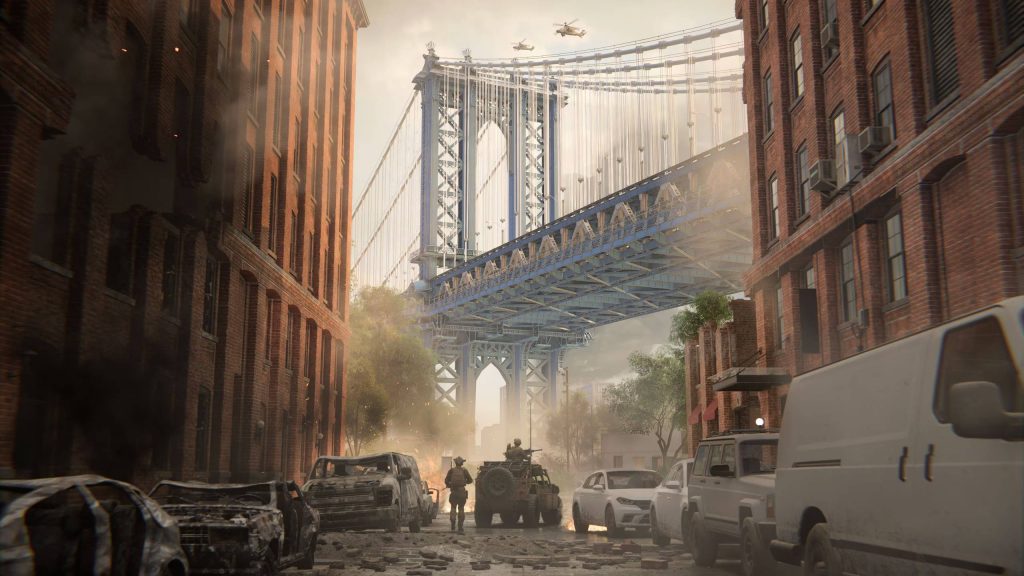Like a radio-friendly rock band dabbling in avant-garde, DICE’s long-running shooter series entered an experimental phase with Battlefield 2042, and the results were polarising: massive 128-player battles, futuristic settings, and Specialist Class systems were detours too divisive for many fans to stomach. Post-launch updates salvaged the game’s reputation, but players have been yearning for a return to the series’ roots. Sometimes, rock stars just need guitars.
Battlefield 6 feels like a comeback album; recomposing the franchise’s DNA whilst remixing its best riffs for a modern audience. It distills the series’ trademark chaos into tighter, grittier experiences, and introduces a suite of new motifs and game modes. We’re breaking down 15 of the biggest differences between Battlefield 6 and 2042 – from map design and player counts, to audio philosophy – plus potential weak notes from open beta feedback.
64-Player Battles Return
DICE’s decision to scale battles back to 64 players in its default mode is one of the biggest changes coming to Battlefield 6. As Battlefield 2042 doubled player count to 128, criticism neutralised the intensity of larger-scale warfare as matches became hard to track. Battlefield’s tactical edge was dulled; squad-based strategy peppered by moments of emergent brilliance – defining features of franchise favourites were lost. Reverting to 64-strong matches epitomises Battlefield 6’s attempts at redemption.
More Focused Map Design
Alongside smaller player counts, Battlefield 6’s map design has undergone a rethink. Whilst solid, large-scale options exist in Battlefield 2042, too many of its maps lacked meaningful flow, instead funneling infantry into convoluted corridors, or aimlessly pushing squadrons to open terrain. Battlefield 6 brings diverse maps drawing from real-world inspiration including Gibraltar, or Brooklyn, New York. Each features Adaptively Designed Combat Zones, spaces shaped to fit the requirements of different game modes, thus reinforcing tactical variety.
Modern Day Setting
Another of Battlefield 2042’s contentious points was its futuristic setting, eschewing the series’ contemporary tone for sci-fi gadgetry, hovercrafts, and robot dogs. Battlefield 6 is set to re-embrace the series’ signature groundedness, replacing blackout catastrophe and climate disaster with conflict rooted in current-day geopolitics. The change is resonating well with players, as modern military hardware, globally recognisable locations, and realistic body armour delivers an experience which feels plausible rather than dystopian.
The Kinesthetic Combat System: Refined Movement
Perhaps Battlefield 6’s boldest new feature is its Kinesthetic Combat System, a complete reimagining of how infantries move, shoot, and interact with the environment. Movement is the redesign’s beating heart, with new mechanics Drag and Revive letting players pull downed squadmates to safety whilst reviving them, and Lean and Peak allowing soldiers to look around and take shots out of cover without fully exposing themselves to enemy gunfire. Crouch Sprints and Combat Rolls add new layers of tactical movement by increasing evasive maneuverability when under fire.
The Kinesthetic Combat System: New Mechanics
Battlefield 6’s Kinesthetic Combat System is being introduced specifically to combat the relatively stiff infantry movesets of 2042 which led to tactical and strategic situations feeling less dynamic. Other additions include options for how players interact with the environment, from Weapon Mounting allowing arsenal to be braced against walls to reduce recoil, to a Hitch-a-Ride system which lets infantry physically cling to allied vehicles to zip across the map in tandem.
Expanded Tactical Destruction

Destruction is a Battlefield trademark, yet Battlefield 2042 delivered building damage via scripted events that were limited in scope. Battlefield 6 emphasises player-driven destruction, with everything from grenades and sledgehammers, to terraforming bombs giving squadmates countless ways to level the battleground on-the-fly. Walls can be blown apart to reveal new sightlines, whilst entire strongholds can be dismantled over the course of a match. The result should yield battles which feel more fluid and unpredictable, yet still offering strategic benefits that reward creative play.
War Tapes VAL
Central to Battlefield’s immersion is its sound design, with the best way to audibly experience the series’ explosive ferocity arguably being to turn on the game’s War Tapes audio setting. Introduced in Bad Company 2, War Tapes compresses the audio mix, boosting grit, saturation, and distortion, transforming balanced audio into confrontational sound. 2042 was criticised for its flat, clean soundmix, so Battlefield 6 brings a new audio standard: War Tapes VAL. Taking the War Tapes blueprint, VAL – short for Very Aggressive Listening – offers the most terrifying sound design of any Battlefield game so far. Gunfire crackles, missiles whir, and shells explode with eardrum-punishing penetration, whilst traditionally lower volume sounds such as footsteps, rustling clothing, and expelling bullet casings perforate the airwaves with newfound force.
Weightier Gunplay
Beta impressions suggest that Battlefield 6’s weapon handling has improved. Guns feel heavier, snappier, and more powerful in play, with renewed tactility supported by crisper recoils and more detailed animations. Where Battlefield 2042’s weapons felt clunky and unrealistic – no doubt symptoms of its futuristic aesthetic – Battlefield 6 delivers satisfying gunplay that feels impactful, satisfying, and looks great too.
The Return of Single Player
In addition to redefining Battlefield’s multi-player experience, Battlefield 6 is also re-introducing a single player campaign; a turnaround from one of 2042’s biggest omissions. Set in 2027, and centring on a conflict between a fractured NATO and private military company Pax Armata, Battlefield 6’s character-driven, single player narrative is shaping up to satisfy 2042 players who missed a cinematic reason to experience the game’s large-scale battles beyond multi-player.
Classic Class System Restored

Battlefield 6 answers another fan request by restoring the Classic Class System, with Assault, Support, Engineer, and Recon roles available at launch, wiping clean 2042’s Specialist mess; a controversial class system which overly-fragmented squad roles, despite elements being re-integrated post-launch. Classes now have their own distinct perks, equipment, and gadgets again, restoring a sense of individual identity missing in 2042. Weapons are still universal rather than class-locked, but the overall structure looks to once again foster team-based synergies.
New Multiplayer Mode
Battlefield 6 isn’t just set to iterate on staple multiplayer modes Conquest and Breakthrough, but is introducing a new match type to the fold: Escalation. Ramping up the control-point concept of Conquest, Escalation’s twist is that once a team maintains a stranglehold on a specific point for enough time, the point disappears. With seven locations spread across the map, skirmishes will grow in intensity as territorial space dwindles. Fan-favourite King of the Hill is set to return too, with squads battling to control a single, rotating control-point across smaller maps.
Fully-Fledged Battle Royale Mode Incoming
Where Battlefield 2042 left Battle Royale to community-made Portal creations, Battlefield 6 is delivering an official, developer-supported Battle Royale mode. Taking place on an all-new map tailor-made for the Battle Royale experience, expect an environment pockmarked by control-points and layered by undulating terrain, with conflict zones designed to support Battlefield’s large-scale warfare. Shaking up the formula is “the deadliest ring in BF”, a slowly-shrinking zone which eliminates soldiers on contact, pushing them into increasingly fearsome firefights.
Portal Mode Upgraded
Speaking of Portal, Battlefield 6 enhances the creative suite introduced in 2042 with better scripting, level-customising tools, and UI integration, making it similar in scope to Fortnite’s Unreal Editor and Halo’s Forge. The developers are investing a lot into Battlefield 6’s Portal, in part due to player feedback suggesting fans don’t want a Battlefield game they can ‘complete’. With a dedicated server browser, it’ll be easier for players to discover the maps and modes they want to play.
Anti-Cheat Overhaul

Battlefield 6 migrates from 2042’s EA Anti-Cheat to Javelin Anti-Cheat, a more robust system with Secure Boot requirements from day one. Arriving during Battlefield 2042’s sixth season, Secure Boot brought concern amongst players as certain systems are not able to meet its security standards. Whilst Javelin Anti-Cheat should hold off cheaters for now, it seems the balancing act between fairness and accessibility is set to continue.
Remaining Concerns
Battlefield 6’s launch is not without controversy, with the open beta highlighting a handful of potential pain points. For instance, vehicles – once overpowered in 2042 – show signs of being underpowered and too easily destroyed. Map size, whilst tighter, can veer towards claustrophobic, with firefights breaking out almost constantly. And reports of spiky TTK and TTD suggest DICE are still tweaking weapon balance and effectiveness.
Whilst these complaints arise from Battlefield 6’s open beta, both players and EA recognise this phase as positive for the game. There’s no sign yet that Battlefield 6 is swapping one set of problems out for another.




Great comparison between Battlefield 6 and Battlefield 2042! It’s interesting to see how the series evolves while trying new things. Looking forward to more discussions on the changes and improvements!
Thank you! It really highlights the evolution of gameplay mechanics over the years. The shift towards more dynamic environments in Battlefield 2042 certainly adds a unique layer that could redefine strategy in multiplayer matches.
You’re welcome! It’s fascinating to see how DICE has embraced new technologies to enhance player experiences. The introduction of larger maps in Battlefield 2042 really changes tactical gameplay, making team coordination even more crucial.
Absolutely! The integration of advanced AI and dynamic weather systems really sets Battlefield 2042 apart. It creates a more immersive experience that can change the course of gameplay in unexpected ways.